|
KIA Cee'd
Debut: 2007
Maker: KIA
Predecessor: no |
|
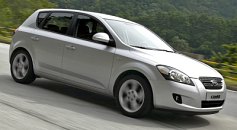 Kia
Cee'd might be built on the same platform as Hyundai Elantra, but it
looks much prettier, handles far better and is built with higher
quality. Never before Kia had produced a car so competitive. Never
before it had presented so serious threat to the European giants
Volkswagen, Ford, Opel, PSA and Renault. The story started 5 years ago… Kia
Cee'd might be built on the same platform as Hyundai Elantra, but it
looks much prettier, handles far better and is built with higher
quality. Never before Kia had produced a car so competitive. Never
before it had presented so serious threat to the European giants
Volkswagen, Ford, Opel, PSA and Renault. The story started 5 years ago…
The Plan
In 2002, Kia head hunted Frenchman Jean-Charles Lievens to establish
its European R&D operation. The ex-Toyota Europe executive hired
many European designers and engineers from rival makers and installed
them in Hyundai and Kia's joint R&D center in Russelsheim of
Germany, i.e., the backyard of Opel ! in the beginning, the R&D
center was responsible for developing advanced common-rail injection
diesel engines for use in Europe. This resulted in the state-of-the-art
1.6CRDi and 2.0CRDi engine. Then it also took the leading role in
designing a new C-segment family hatch for European market. This is
Cee'd.
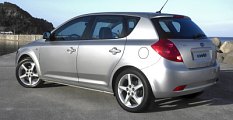 Designed by European designers, the Cee'd
looks far more modern and stylish than its Hyundai cousin (which was
designed in Korea). It is prettier than Ford Focus, Toyota Auris and
Mazda 3, if not have as strong personalities as Renault Megane, Opel
Astra or Volkswagen Golf. Lievens also persuaded the headquarters to
give the car top-class materials in its cabin. Besides, every aspect of
the car was benchmarked against Peugeot 307, Volkswagen Golf and Ford
Focus. For example, the aerodynamic drag coefficient of 0.33 and lift
coefficient of 0.01 are better than Golf and Focus. Torsional rigidity
of the monocoque chassis is 27% higher than Focus. Finally, to make
sure the car handles and rides brilliantly, a fleet of prototypes were
tested extensively in Europe under the watch of Russelsheim. Some 1
million of test kilometers were covered to fine tune the suspensions,
steering, brakes etc. and sorted out quality problems. In the end, Kia
is so confident that it dares to offer 7 years and 150,000 km warranty
to the car, more than any other European car makers ! Designed by European designers, the Cee'd
looks far more modern and stylish than its Hyundai cousin (which was
designed in Korea). It is prettier than Ford Focus, Toyota Auris and
Mazda 3, if not have as strong personalities as Renault Megane, Opel
Astra or Volkswagen Golf. Lievens also persuaded the headquarters to
give the car top-class materials in its cabin. Besides, every aspect of
the car was benchmarked against Peugeot 307, Volkswagen Golf and Ford
Focus. For example, the aerodynamic drag coefficient of 0.33 and lift
coefficient of 0.01 are better than Golf and Focus. Torsional rigidity
of the monocoque chassis is 27% higher than Focus. Finally, to make
sure the car handles and rides brilliantly, a fleet of prototypes were
tested extensively in Europe under the watch of Russelsheim. Some 1
million of test kilometers were covered to fine tune the suspensions,
steering, brakes etc. and sorted out quality problems. In the end, Kia
is so confident that it dares to offer 7 years and 150,000 km warranty
to the car, more than any other European car makers !
Cee'd
is not only designed and tuned in Europe, but also produced in Europe. A
new plant in Zilina, Slovakia, will produce 100,000 Cee'ds this year
and 150,000 units from 2008. If the reception exceed estimation, the
plant can output up to 300,000 units. Furthermore, its twins sister
car, Hyundai i30, is going to enter production in another new plant
in Nosovice, Czech Republic, which is only 95km from Zilina to take
advantage of the same supply chains. That plant has another 200,000
units of capacity. Sorry to European car makers…
The Car
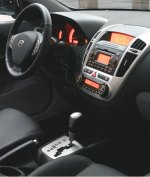 To Korean car makers, quality
will be the key of success, or failure. From the tight panel fittings
and fine paint finish, the Slovakia factory seems to achieve the same
high quality standards as Wolfsburg or Russelsheim. Open the doors, the
cabin continues to impress you with a sense of style and quality. The
dashboard design is tasteful. The instruments are clear. The switch
gears are ergonomically placed. Almost everywhere is made of soft-touch
plastics and solidly assembled in the same way as Volkswagen Golf. All
switches and buttons work smoothly and precisely. Besides, there are
some expensive features, such as the dials and displays illuminate in
soft orange at night, a glovebox cooled by air conditioning, or the
availability of an i-Pod socket. The standard audio system is also a
good one. If there are anything preventing it from rivaling Volkswagen
Golf ultimately, they must be the shiny hard plastics used in door
handles and power window switches, or the unsupportive front seats. To Korean car makers, quality
will be the key of success, or failure. From the tight panel fittings
and fine paint finish, the Slovakia factory seems to achieve the same
high quality standards as Wolfsburg or Russelsheim. Open the doors, the
cabin continues to impress you with a sense of style and quality. The
dashboard design is tasteful. The instruments are clear. The switch
gears are ergonomically placed. Almost everywhere is made of soft-touch
plastics and solidly assembled in the same way as Volkswagen Golf. All
switches and buttons work smoothly and precisely. Besides, there are
some expensive features, such as the dials and displays illuminate in
soft orange at night, a glovebox cooled by air conditioning, or the
availability of an i-Pod socket. The standard audio system is also a
good one. If there are anything preventing it from rivaling Volkswagen
Golf ultimately, they must be the shiny hard plastics used in door
handles and power window switches, or the unsupportive front seats.
Given
a 2650 mm wheelbase and 1790 mm width, it is unsurprising that the car
offers a roomy cabin. There is more shoulder room and rear legroom than
most cars in the class.
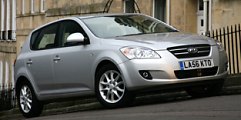 As mentioned, the chassis of
Cee'd is very stiff. Some 67 percent of the body-in-white is made of
high-strength steel. Both front and rear suspensions are attached to
subframes to decouple from shocks and vibration. To save weight, the
front subframe is produced by hydroformed process. Suspensions are
MacPherson struts up front and, listen, multi-link system at the rear.
The latter consists of dual transverse links and a longitudinal leading
arms. It goes without saying that multi-link suspension provides
superior handling and ride compare to conventional torsion-beam
suspension, otherwise Focus and Golf would not have won so much praise. As mentioned, the chassis of
Cee'd is very stiff. Some 67 percent of the body-in-white is made of
high-strength steel. Both front and rear suspensions are attached to
subframes to decouple from shocks and vibration. To save weight, the
front subframe is produced by hydroformed process. Suspensions are
MacPherson struts up front and, listen, multi-link system at the rear.
The latter consists of dual transverse links and a longitudinal leading
arms. It goes without saying that multi-link suspension provides
superior handling and ride compare to conventional torsion-beam
suspension, otherwise Focus and Golf would not have won so much praise.
On
the
road, Cee'd handles very much like German cars. Its ride is rather firm
– firmer than both Focus and Golf – but in return it gets good
handling. It corners stable and feels agile to steer. The electric
power steering is quick and accurate, if not very communicative. Smooth
gearshift and well judged braking complete the fine driving experience.
Ultimately, Focus is more talented while Golf is more rounded, but the
Kia is already one of the best drives in the class, and the best ever
for a Korean car.
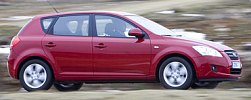 The powertrain is also up to
the job. Hyundai group's 1.4 and 1.6-liter CVVT petrol engines are
reasonably smooth and eager, but the most impressive is the
Slovakia-built 1.6CRDi turbo diesel, as it is gusty, refined and frugal
simultaneously. Not so good is the 2.0-liter petrol and 2.0CRDi,
because both of them sounds noisier and vibrates more than the smaller
engines. The powertrain is also up to
the job. Hyundai group's 1.4 and 1.6-liter CVVT petrol engines are
reasonably smooth and eager, but the most impressive is the
Slovakia-built 1.6CRDi turbo diesel, as it is gusty, refined and frugal
simultaneously. Not so good is the 2.0-liter petrol and 2.0CRDi,
because both of them sounds noisier and vibrates more than the smaller
engines.
Overall speaking, Cee'd is a surprising success from Hyundai-Kia group.
Although it is not yet in the league of Golf and Focus, it beats most
rivals fairly, even before considering its keener price and generous
standard equipment. Oh yes, and the attractive 7-year / 150,000 km
warranty. |
| The
above report was last updated on 7 Feb 2007. All
Rights Reserved. |
Sister car: Hyundai i30
|
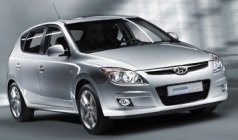 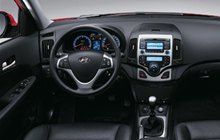
Hyundai i30 is basically a
Cee'd
with different clothes. Hyundai wants to make it appear to be more
luxurious and classy, but in the end its design is neither as stylish
as nor as tasteful as Cee'd. Mechanically, the car is identical to its
Kia sister, including powertrains and chassis. Only a slightly softer
ride sets it apart. You can also see similar seats and dashboard
structure in its cabin. Although the Hyundai is built in Czech Republic instead of
Slovakia, its factory is only 95km from the Kia's one, so both cars can
share the same supply chains. As the Hyundai asks for a higher price
for virtually the same thing, I can't see the point of purchasing it.
|
| The
above report was last updated on 7 Mar 2007. All
Rights Reserved. |
Procee'd
|
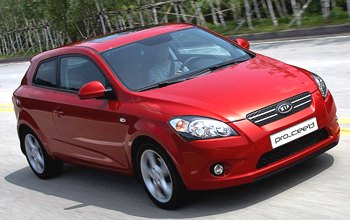
|
Apart from bonnet and front wings,
Procee'd shares no body panels with Cee'd...
|
Forget the different name
(officially "pro_cee'd" but I prefer to skip the underscore), this is
actually the 3-door hatchback version of Cee'd. Kia's European studio
tried hard to differ it from the 5-door. It gave the Procee'd a
sportier proportion - the roof is 30 mm lower, the rear screen angle is
faster, the shoulder more pronounced at the back, the tailgate spoiler
is larger, the characteristic recessed line at the lower part of the
doors get more aggressive, the grille gets thinner and the bumper
intake gets wider... As a result, the body shell of Procee'd shares
only bonnet and front wings with its 5-door sibling. It does look more
stylish, but it won't arouse the same sensation as Opel Astra GTC,
which is still the most successful 3-door-hatch-pretend-to-be-a-coupe
in my eyes.
Without any surprises, inside the car you will find the same dashboard
as the 5-door. Visibility is inevitably worsened by the small rear
windows and thick C-pillars. There is less head room due to the lower
roof. Front occupants still find plenty of headroom, but rear
passengers over 6 feet will find their heads rubbing against the roof,
although legroom remains generous. Access to the rear seats is aided by
large doors that open up to 70 degrees. As expected, the boot is
smaller and the tailgate is smaller too. This is what you have to
sacrifice in exchange for a sportier look.
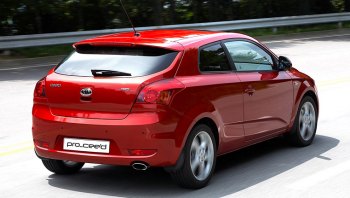
|
Sporty looks alone is not enough...
|
Disappointingly, Kia has no intention to make the Procee'd a real hot
hatch. It has the same engines as the 5-door. In other words, the most
powerful units are 143hp 2.0-liter 16V petrol and 140hp 2.0 turbo
diesel. However, the best engines are actually the smaller 1.6 petrol,
which is smooth and eager, and the 1.6 turbo diesel, which is
considerably more refined and frugal than the larger diesel. Parent
company Hyundai has developed a 2-liter turbo engine for its Genesis
coupe. I hope Kia will adapt it to transverse mounting and put it in
the Procee'd.
For now, the Procee'd drives sportier than the 5-door just because of
stiffer springs and dampers. Unfortunately, its ride is hard to the
extent that uncomfortable on most roads except the smoothest. Hit a
mid-corner bump and its handling could become nervous. It lacks the
fluency and flexibility of the class-leading Ford Focus, VW Golf and
Opel Astra GTC. Apparently, sporty looks alone is not enough. It begs
for a better chassis tuning as well as a stronger engine.
|
| The
above report was last updated on 26 Jan
2008. All Rights Reserved. |
|
|